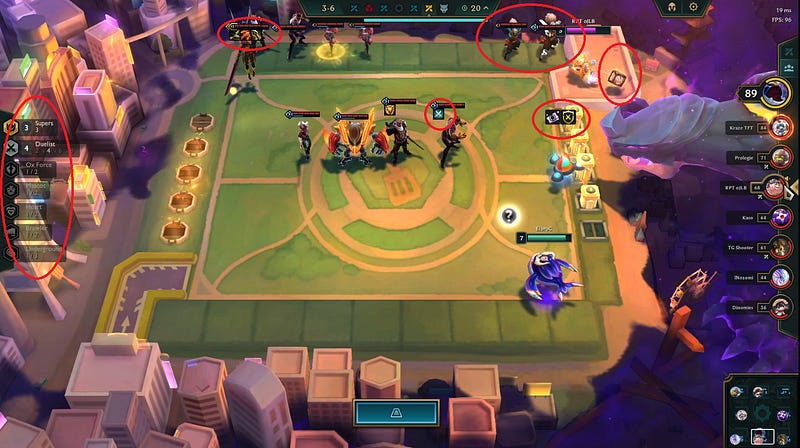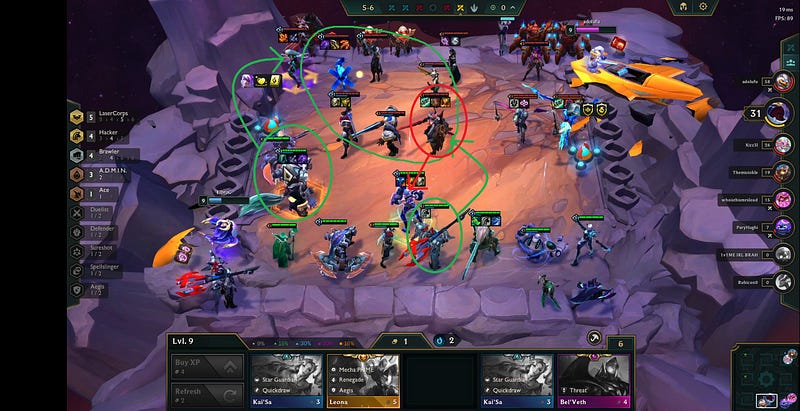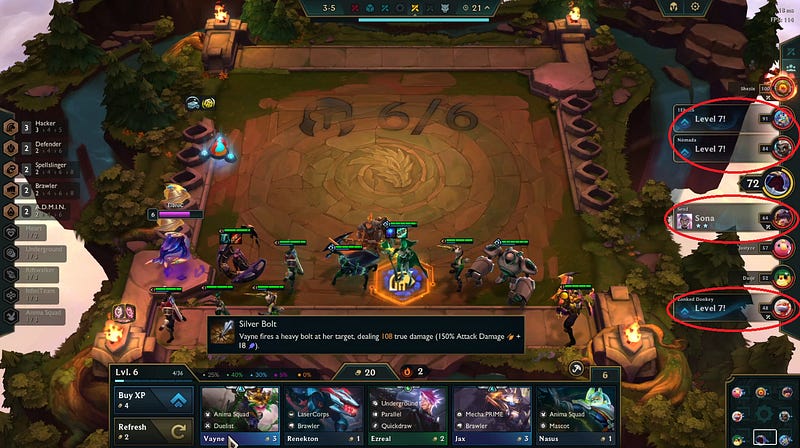How to Scout like a Challenger in TFT
Scouting is a well known concept in TFT, even to the more casual playerbase. But the intricacies of what, how, when and why top players…
Scouting is a well known concept in TFT, even to the more casual playerbase. But the intricacies of what, how, when and why top players scout, is actually pretty complex. So today, let’s dive into 3 main reasons why top players scout, and explain the logic and mental actions behind them so that you can start applying it to your own games !
1 — Scouting to check other players comps
What :
This is probably one of the simplest form of scouting : gathering info about what comps/units/traits your opponents are using or planning to use by the end of the game.
How :
Most people first intuition in how to perform that is by giving a quick look on the left side of their screen to look at activated synergies on enemies boards. While that is a good start to give you an instant snapshot of what is being played in the lobby, this method will only give you partial information. And even worse, it might actually mislead you! Indeed, more advanced players will tend to be very flexible from round to round to always have the strongest board possible, so they might slot in a unit or synergy only for a couple of rounds while never intending to keep them in the long run.
A more advanced way of scouting your opponents comps would be the following : Analysing the units played AND stored on the bench, as well as the full items crafted and augments picked to determine the most probable direction/game plan of your opponent. If you are up to date with what is considered meta in the current patch, you should be able to perceive the decision tree of your opponent based on his current game state and guess the most probable composition he will end up playing.

When :
At top level players will start scouting for this type of information as soon as stage 2–1 or even earlier. Indeed, you can get a pretty good estimation of the potential game plans opponents have in mind from the very early stages, based on their first defining directions like augments, item slam or even 3 cost orb obtained in the first pve. As I always say, time is your most precious resource in TFT, so of course the frequency and time spent scouting will be different each game depending on other actions that needs your attention. But a good rule of thumb to keep in mind is to at least check after every augment choices and pve round, where big transition in game plan and comps tend to happen.
Why :
Finally, why are we paying so much attention to our opponents current or end game compositions? Their is actually layers of complexity even in that question but the most obvious reason is to make sure you are not contested in your own comp/game plan. Indeed, in TFT the champions you get offered in your shops are shared with the rest of the lobby. Which means that if an opponent is looking for the same units as you are, you are lowering each others chance to hit! For this reason, top players will always want to have a good understanding of what their opponents are playing to constantly re- assess was their best game plan is with regards to that info.
However that is not the only value in checking your opponents comps. By knowing what comps/carry your opponents are playing you can try to build your board so that you have a favourable matchup with the majority of the lobby. A few examples :
If you see that 5 out of your 7 opponents are going for AP oriented comps -> you might want to orient your gameplan towards a comps that can easily fit the Aegis synergy or focus more on Negatron Cloak in carrousels to build a Dragon’s Claw.
If you see that 2 players are playing Brawler boards and 2 others are playing reroll boards with a lot of 3 star -> That means that Giant Slayer becomes a very high value item to build.
2 — Scouting to optimise positioning
What :
Scouting for positioning can be done in a lot of way as we will see in the next section, but in essence it drills down one simple thing : looking at your potential next round’s opponents boards and understanding how to position to augment your chance of winning against them.
How :
Scouting for positioning can be very complex and I won’t enter too much in the mind games of taking into account that your opponent is himself scouting your board and might switch is positioning last second. But here is a non-exhaustive list of a few things you want to look for when performing this type of scouting :
- Backline access (hackers, hooks etc.)
- AOE CC (Fiddlesticks, Garen etc.)
- Items (Zephyr, Shroud etc.)
- Enemy carry position
- Main tank on which your carry could get stuck


When :
Short answer: before every round. Even in the very early stages. And I want to insist on that advice because I have noticed that a lot of players understand the value of scouting for positioning but only apply it to mid-late game. And I promise you that fixing that mistake will improve your ability to win streak early very substantially, as we will discuss in the next section.
Why :
Positioning is key in TFT, and can separate and round loss from a win quite often, and good scouting is en essential component to optimize your positioning. Beyond the straightforward benefit of losing less hp, optimizing your positioning by scouting also helps you secure your streaks. Even lose streaks, as you can scout to identify weak opponents that would ruin your lose streak and intentionally weaken your board if their are in your rotation. This in turns optimize your economy generation, allowing you to cap your board earlier and so on.
3 — Scouting to understand relative board strength and game tempo
What :
This is the most advanced type of scouting, as it requires a very good understanding of the game fundamental mechanics to be impactful. But it is maybe the most valuable of the 3 at top level. What it means is basically scouting your opponents’ boards to get a good idea of the the overall power level of the lobby and help you decide how aggressive/greedy you should be to keep up with tempo. We will get more in-depth with those concepts in the “Why” section
How :
There are actually two ways to perform this type of scouting : passively and actively.
The active version is the most obvious and his often done in conjunction with compositions scouting by cycling through every opponent. In that case though, you will need to focus more on things like combat augments, star level of champs, number of units on the board, itemization of carries and tanks etc.

The passive way of scouting for lobby tempo/strength is via the players list on the right side which have the feature of displaying a message when a player hit a 2 or 3 star unit as well as level up. This is very beneficial to develop the capacity to gather these info as they pop-up even while you are performing another action like rolling, positioning etc.

When :
Again, the short answer would be as often as possible. But just like for composition scouting, you at least need to do it in key moments of the game like post pve and post augment choice. Indeed, these are the most common rounds during which your opponents might roll down and drastically improve the power level of their board. Carousel are also an opportune time to cycle through your opponent boards since you cannot perform any actions on yours during this round.
Why :
Understanding the power level/tempo of the lobby is a crucial information that helps you make the best decisions. For example, imagine you are in stage 3–2 with a relatively weak board and a bunch units pairs that could be upgraded with a few rolls. You are confronted with the following options :
A : Rolling 10–20 golds to upgrade a few units and stabilize your board
B : Keeping your golds until the next pve and hope to not bleed to many hp in stage 3.
By scouting properly during this key moment, you might notice that the rest of the players is the lobby are not rolling much and have quite weak boards themselves but are keeping a very healthy economy. That means that they are aiming to play a weak/greedy stage 3 to aim for a higher capped late game. That should confirm to you that keeping your golds for now is the right decision since that would not put you too far behind the tempo of the lobby.
On the contrary, if you did not scout and decided to roll anyway you would have been putting yourself in a serious economic disadvantage in the later stages, in exchange for saving a few hp (you were not actually in danger of suffering heavy losses) and applying relatively insignificant pressure yourself to the bottom lobby players, by being the only one with a strong board.
And that was the three main reasons why top players scout in TFT. Of course, there is more to it and every game is different so these guidelines can and should be adapted to fit your needs. TFT is a very complex game in which every core mechanic can devolve in a rabbit hole of intricacies and specificities, and that is what make TFT such an incredible game in my opinion !
Anyway, hope you enjoy the read and may Mortdog bless your rolls !

